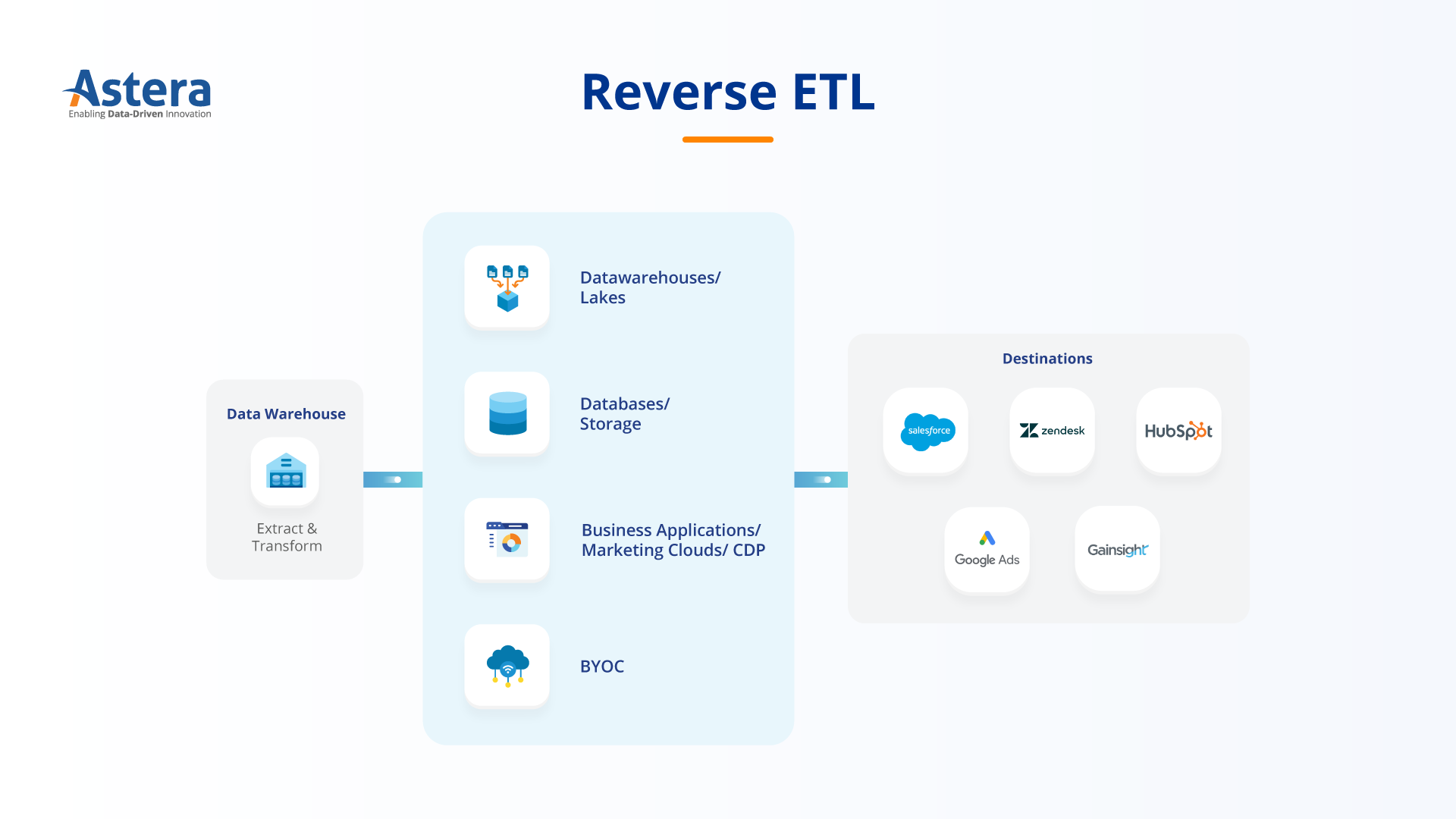What is Reverse ETL?
Reverse ETL is the process of moving data from the central data warehouse to operational and analytic tools, therefore, it’s essentially an ETL process, except the data moves in the opposite direction. Reverse ETL is essential for businesses that use various tools, such as CRMs, marketing automation platforms, and sales tools, as it enables seamless data flow and empowers informed decision-making for growth, marketing, sales, and support.

Reverse ETL ensures that the most up to date data is available in Business Intelligence (BI) and visualization tools, and data visualization, making them more effective and efficient in their operations. Put simply, reverse ETL is an important element in the modern data stack and helps businesses get the right data to the right tools at the right time, making their work easier and more productive.
How Does Reverse ETL Fit in Your Data Infrastructure
Reverse ETL helps bridge the gap between data warehouse and operational applications and systems. It fits into your data infrastructure to deliver up-to-date data to business teams, enabling them to make informed decisions.
By integrating with pre-built connectors, reverse ETL eliminates complex configuration and simplifies the process of moving data out of the warehouse. This facilitates the real-time flow of data from data warehouse to reporting dashboards and operational analytics tools, accelerating data processing and providing business leaders with timely information.
Reverse ETL, used with other data integration tools, like master data management (MDM) and change data capture (CDC), empowers employees to access data easily and fosters the development of data literacy skills, which enhances a data-driven culture. This accessibility allows teams to experiment with data, iterate their strategies, and drive innovation.
Additionally, reverse ETL supports data governance by providing visual representations of data lineage, versioning support, and historical data tracking, enabling organizations to maintain policies and adapt strategies rapidly when necessary.
ETL vs Reverse ETL
| ETL | Reverse ETL |
| Purpose | Aggregates and organizes data from various sources for analytical processing. | Distributes processed data from the data warehouse to operational systems for action. |
| Direction of Data Flow | From source systems (like databases, CRM, ERP) to a centralized data warehouse. | From a centralized data warehouse to operational systems and applications. |
| Primary Users | Data engineers and analysts who prepare and analyze data. | Business users in marketing, sales, customer service, and operations who execute data-driven actions. |
| Data Movement | One-way data flow into a data warehouse for storage and analysis. | Cyclic data flow, enabling operational systems to be updated with insights from the warehouse. |
| Primary Focus | Integrating, cleansing, and storing data for reporting and analysis. | Operationalizing insights from stored data and making them actionable in day-to-day business operations. |
| Use Cases | Data warehousing, business intelligence, reporting, and data analytics. | Data enrichment for CRM, targeted marketing campaigns, real-time customer interaction, and personalized experiences. |
| Impact on Business | Facilitates data-driven decision-making through historical analysis and reporting. | Enhances operational efficiency and customer experiences by leveraging insights in real-time business processes. |
Simplify your ETL and Reverse ETL processes!
Astera Centerprise makes ETL and reverse ETL processes super easy using its drag-and-drop interface, cutting significant amounts of time and money investments – all while using zero code!
Try now – 14 days free! Functionalities of Reverse ETL
Reverse ETL makes stored information accessible to the people who need it. This means that teams like Sales, Marketing, and Customer Support can use this information to make informed decisions and provide more personalized experiences for customers. Instead of just having a bunch of complicated datasets sitting around, businesses can use this data to improve their day-to-day operations.
- First, reverse ETL can operationalize data by turning abstract information into something measurable and useful for businesses. For example, sales teams can use Reverse ETL to import customer data from the data warehouse into a CRM system like Salesforce. This data could include customer purchase history and interaction logs, enabling the sales team to tailor their pitches and follow-ups to individual customer needs and preferences.
- Reverse ETL tools help access data from different departments within the company. This means that teams can easily find relevant information without having to ask someone else to create a report. With these tools, it’s easy to break down data silos and access related information. For example, HR teams can use Reverse ETL to pull data from employee surveys stored in a data warehouse into HR management systems. This could help in identifying patterns in employee feedback related to workplace satisfaction or areas for improvement.
- Reverse ETL combined with data warehouse helps data analysts save time allowing them to focus on more complex tasks such as making sure their data is high quality, keeping it secure and private, and identifying the most important metrics to track.
Guide to the Workflow of Reverse ETL
There are four main aspects to reverse ETL:
Data Source: It refers to the origin of data, like a website or a mobile app.
Data Models: These define the specific sets of data that need to be moved. For-example a set of customers purchased behaviors compiled for analysis.
Destinations: These are the places where the data set is directed, like data sent to a marketing automation tool.
Data Mapping: Mapping is the process of aligning your data from the warehouse to fit specific fields in target destinations. For instance, aligning customer ID fields in the data warehouse with the corresponding fields in a Salesforce CRM.
The process basically starts with data extraction and ends with flawless data activation.
- Extraction
It is the process of extracting data from data warehouse using an automated data extraction tool and data integration platforms, specifically designed for handling and transferring large volumes of data efficiently.
2. Transformation
After obtaining data it needs to be transformed, to fit the format of its destination. In this case, data mapping comes in handy as it can trace the movement of data between storage systems and tools and put it into specific fields.
3. Loading
Next, load the transformed data into its target destination using various methods. For example, using an API for a direct connection, batch processing for handling large volumes of data at once, etc.
4. Activation
Once the data is loaded into downstream tools and applications, it can be used by internal teams and even trigger specific actions automatically, like sending personalized emails to customers based on their behavior.
5. On-going Monitoring
The final step is to keep an eye on the process. Organizations employ holistic data integration and management tools alongside Reverse ETL tools for monitoring. This ensures a smooth and reliable data flow between their centralized data repository and operational systems. These tools can spot issues like errors or failed data transfers, maintaining data quality and reliability.
To determine if reverse ETL is the right fit for your business, it’s important to understand its practical applications. Let’s explore a few examples of how companies can benefit from implementing reverse ETL.
Data Activation
When it comes to SSA or analytics enablement, businesses tend to focus on the human aspect of it, emphasizing the user’s ability to easily understand and interact with the data. But the way data is presented is equally important, as it directly impacts how users comprehend, interpret, and make decisions based on the data.
By providing data insights, businesses can make their data warehouse more accessible and usable for their employees. With Reverse ETL, businesses can automate the flow of data between their data warehouse and operational systems, making it easier for employees to access the data they need to make informed decisions.
For example, analysts can feed lead ratings from the data warehouse into a custom field in Salesforce, which can then be used in any operational analytics use case to obtain new business. This eliminates the need for sales staff to use BI reports and allows them to focus on closing deals.
Data Automation
As organizations grow, their process flows become increasingly complex, making it difficult to identify which processes are causing problems in both internal and external operations. Reverse ETL automates the transfer of data from centralized data warehouses to various operational systems.
It uses SQL to extract and synchronize data to external tools, making the process straightforward and efficient. This automation ensures that any changes in the data warehouse are instantly reflected in other tools.
It can also trigger automated actions in business applications based on the synced data. It reduces errors and ensures all systems in the organization use the most current data, enhancing overall data quality management.
Personalizing Customer Experience
Reverse ETL serves as a data infrastructure option that can generate personalized in-app consumer experiences by synchronizing data from your warehouse to production databases via social media or e-commerce platforms.
It establishes a data pipeline that extracts relevant data from the centralized data warehouse. This data is transformed and loaded into production databases that power the application. By leveraging social media or e-commerce platforms as intermediaries, this process ensures that real-time and up-to-date information, such as user preferences or purchase history, is readily available within the application.
This, in turn, increases customer happiness and loyalty, benefiting businesses through Customer Lifetime Value and revenue generation.
Financial Data Integration
Reverse ETL is an important component in the financial sector for streamlining transaction processing. It integrates data from analytics platforms into accounting or financial management systems, ensuring that financial records are always up-to-date and accurate.
With this approach, transactional data like sales or expense details can be seamlessly transferred from a data warehouse to financial systems. For instance, retail businesses can use this to sync daily sales data from an analytics tool to their accounting software. This means that every transaction recorded in the sales system is automatically reflected in the financial records, reducing manual data entry errors and ensuring financial data integrity.
The real-time updating feature is particularly useful for financial reporting, budgeting, and planning. It enables financial teams to make informed and timely decisions, leading to better outcomes.
Inventory Management
Reverse ETL is beneficial to inventory management by ensuring that product availability and inventory levels are accurately reflected on e-commerce platforms. Businesses can synchronize inventory data from a centralized data warehouse to their e-commerce platform, providing real-time information about product availability to their customers.
For instance, an online fashion retailer can use this method to update inventory levels from their warehouse management system to their online store. This way, if a particular item is selling quickly, the website’s inventory data gets promptly updated, preventing over-selling. Similarly, when new stock arrives, it is instantly available, maximizing sales opportunities.
This accurate inventory management not only enhances customer experience by providing reliable information but also optimizes stock levels, reducing the probability of excess inventory or stockouts.
Final Word
Reverse ETL is a necessity for businesses looking to utilize the power of their data. To make the most of this transformative process, it’s essential to have the right tools in place, and Astera’s data integration tool is the perfect solution. With its seamless integration and efficient ETL capabilities, Astera empowers businesses to unlock the full potential of their data and drive real-time decisions.
So why wait? Start your journey today with a free 14-day trial of Astera’s ETL tool and experience data-driven success firsthand.
Authors:
![]() Zoha Shakoor
Zoha Shakoor


